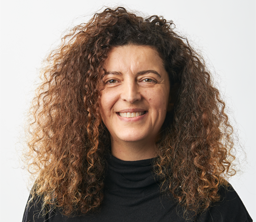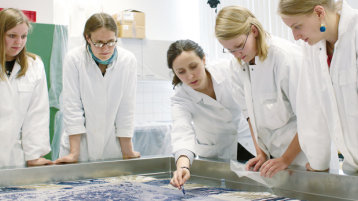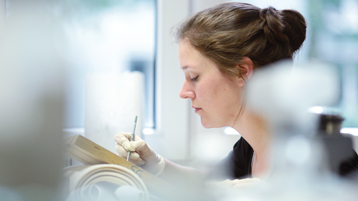Low molecular weight cellulose ethers as aerosol for the consolidation of cohesively weak paints

Charlotte Stahmann dedicated her master’s project to the consolidation of cohesively weak paint layers. She investigated low molecular weight cellulose ethers as consolidants and the influence the physicochemical properties of liquid consolidants have on their penetration behavior. Furthermore, she evaluated the consolidants’ ability to increase the paint layer's cohesion.
At a glance
| Kategorie | Beschreibung |
|---|---|
| Student project | Use of low molecular weight cellulose ethers as aerosol for the consolidation of cohesively weak paint layers |
| Supervisors | Prof. Dr. Ester S. B. Ferreira |
| Dipl.-Rest. Petra Demuth | |
| CICS department | Paintings, Sculptures and Modern Art (GSM) |
| Natural Sciences | |
| Student | Charlotte Nora Stahmann |
| Project partners | Cologne University of Applied Sciences, Andreas Käckel Institut für Produktentwicklung und Konstruktionstechnik (IPK) |
| Cologne University of Applied Sciences, Prof. Dr. Birgit Glüsen and Roxanne Engstler Faculty of Applied Natural Sciences | |
| Munch Museum Oslo, Eva Storevik-Tveit | |
| Bern University of the Arts, Prof. Dr. Karolina Soppa (fluorescence labeling) | |
| Fraunhofer IIS/ University of Würzburg, Dr. Christian Fella und Dominik Müller (Nano- and Synchrotron- Computer tomography) | |
| RWTH Aachen University, Prof. Dr. Bernhard Blümich (Nuclear-Magnetic-Resonance) | |
| Duration | September 2018 - February 2021 |
| Location | Cologne University of Applied Science, Cologne Institute of Conservation Sciences (CICS) |
Picture gallery
 0 / 0
0 / 0
Edvard Munch, Beach Landscape with Trees and Boats, 1905-06 (Photo: Ove Kvavik, Munch Museum Oslo). Microscope images of the paintings cohesively weak paint layers, which in some areas show additional loss of adhesion to the canvas support. (Image: TH Köln- CICS- Charlotte Stahmann)
 0 / 0
0 / 0
Test paintings (ultramarine blue pigment in casein on canvas), produced in accordance with the materials analyzed in a paint particle from the painting “Beach Landscape with Trees and Boats” (Fig 1.) by E. Munch. (Image: TH Köln - CICS - Charlotte Stahmann)
 0 / 0
0 / 0
Scanning electron microscope image (40.000 x) taken from the surface of a test paint layer (Fig. 2). The casein binder has formed nano bridges (marked in orange) which connect the single pigment particles. (Image: TH Köln - CICS - Ester Ferreira/Charlotte Stahmann)
 0 / 0
0 / 0
Thin section showing the cross-section of a test paint layer on canvas after the aerosol consolidation with a fluorescence-labeled low molecular cellulose ether (3,5% in water). The labelled consolidant fluoresces green-blue and makes it possible to detect the penetration depth. Blue light-excitation (470 nm), 6,3 x magnification. (Image: TH Köln- CICS- Charlotte Stahmann)
Conservators apply liquid consolidant by brush or as an aerosol onto the surface of cohesively weak paint layers, hoping that it will penetrate and thus stabilize the layer homogeneously without modifying the surface’s optical properties.
Charlotte Nora Stahmann dedicated her master’s project to the consolidation of cohesively weak paint layers with aerosols. The project was supervised by Prof. Dr. Ester S. B. Ferreira and Dipl.-Rest. Petra Demuth. The Munch Museum in Oslo was a cooperation partner.
Stahmann evaluated low molecular weight hydroxypropyl methylcellulose ethers (HPMC), new in the field of conservation, as possible alternatives to consolidants traditionally used for paint layer consolidation (sturgeon glue and methylcellulose). She investigated the liquid consolidants’ physicochemical properties and their influence on the consolidants’ penetration into porous paint layers. Furthermore, the consolidants’ ability to increase the paint layer's cohesion was evaluated. The test paint layers used for this purpose were produced according to analysis results (pigment, binder, pigment-binder ratio) of a paint sample from a painting by Edvard Munch (Fig. 1, Fig. 2, Fig 3).
Different methods (Nuclear-Magnetic-Resonance, Nano- and Synchrotron-Computer Tomography) were assessed for the visualization of the penetration depth of fluid consolidants applied as aerosols. Finally, and supported by Prof. Dr. Karolina Soppa, fluorescence labeling was used for the evaluation of the penetration depth (Fig. 4). The results show that both the application method as well as the physicochemical properties (particularly the viscosity) of the liquid consolidants have a major impact on their penetration behavior.
This project was executed with a strong interdisciplinary approach. It profited strongly from the support of several external cooperation partners and the versatile infrastructure and competence available at different faculties of the Cologne University of Applied Science.
Andreas Käckel, along with his students Kevin Inden, Dominik Roth and Marius Hasenbach from the Institute of Product Development and Engineering Design, developed an automated two-axis-working table. This table allowed, for the first time, for a reproducible and standardized application of consolidant as aerosol on test paint layers (Fig. 5). Prof. Dr. Birgit Glüsen and Roxanne Engstler from the Faculty of Applied Chemistry aided in the study of the consolidants’ physicochemical properties.





